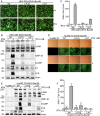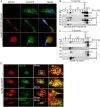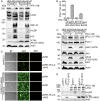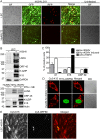The Kaposi's sarcoma-associated herpesvirus (KSHV) non-structural membrane protein K15 is required for viral lytic replication and may represent a therapeutic target
- PMID: 28938025
- PMCID: PMC5627962
- DOI: 10.1371/journal.ppat.1006639
The Kaposi's sarcoma-associated herpesvirus (KSHV) non-structural membrane protein K15 is required for viral lytic replication and may represent a therapeutic target
Abstract
Kaposi's sarcoma-associated herpesvirus (KSHV) is the infectious cause of the highly vascularized tumor Kaposi's sarcoma (KS), which is characterized by proliferating spindle cells of endothelial origin, extensive neo-angiogenesis and inflammatory infiltrates. The KSHV K15 protein contributes to the angiogenic and invasive properties of KSHV-infected endothelial cells. Here, we asked whether K15 could also play a role in KSHV lytic replication. Deletion of the K15 gene from the viral genome or its depletion by siRNA lead to reduced virus reactivation, as evidenced by the decreased expression levels of KSHV lytic proteins RTA, K-bZIP, ORF 45 and K8.1 as well as reduced release of infectious virus. Similar results were found for a K1 deletion virus. Deleting either K15 or K1 from the viral genome also compromised the ability of KSHV to activate PLCγ1, Erk1/2 and Akt1. In infected primary lymphatic endothelial (LEC-rKSHV) cells, which have previously been shown to spontaneously display a viral lytic transcription pattern, transfection of siRNA against K15, but not K1, abolished viral lytic replication as well as KSHV-induced spindle cell formation. Using a newly generated monoclonal antibody to K15, we found an abundant K15 protein expression in KS tumor biopsies obtained from HIV positive patients, emphasizing the physiological relevance of our findings. Finally, we used a dominant negative inhibitor of the K15-PLCγ1 interaction to establish proof of principle that pharmacological intervention with K15-dependent pathways may represent a novel approach to block KSHV reactivation and thereby its pathogenesis.
Conflict of interest statement
The authors have declared that no competing interests exist.
Figures










References
-
- Chang Y, Cesarman E, Pessin MS, Lee F, Culpepper J, Knowles DM, et al. Identification of herpesvirus-like DNA sequences in AIDS-associated Kaposi's sarcoma. Science. 1994;266(5192):1865–9. . - PubMed
-
- Cesarman E, Chang Y, Moore PS, Said JW, Knowles DM. Kaposi's sarcoma-associated herpesvirus-like DNA sequences in AIDS-related body-cavity-based lymphomas. The New England Journal of Medicine. 1995;332(18):1186–91. doi: 10.1056/NEJM199505043321802 . - DOI - PubMed
-
- Soulier J, Grollet L, Oksenhendler E, Cacoub P, Cazals-Hatem D, Babinet P, et al. Kaposi's sarcoma-associated herpesvirus-like DNA sequences in multicentric Castleman's disease. Blood. 1995;86(4):1276–80. . - PubMed
-
- Friedman-Kien AE. Disseminated Kaposi's sarcoma syndrome in young homosexual men. Journal of the American Academy of Dermatology. 1981;5(4):468–71. . - PubMed
-
- Ganem D. KSHV and the pathogenesis of Kaposi sarcoma: listening to human biology and medicine. The Journal of Clinical Investigation. 2010;120(4):939–49. doi: 10.1172/JCI40567 . - DOI - PMC - PubMed
MeSH terms
Substances
LinkOut - more resources
Full Text Sources
Other Literature Sources
Medical
Research Materials
Miscellaneous

